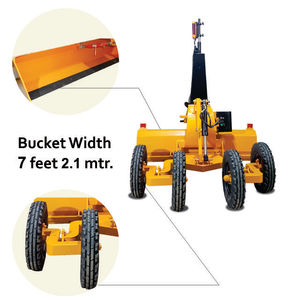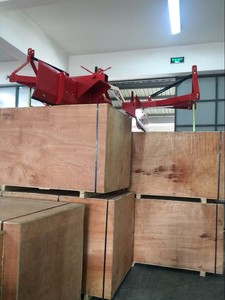(4919 products available)














































































































































































































A land leveler is an important agricultural machinery used to level uneven land. It has many useful applications in a farm such as improving drainage, increasing the area available for planting crops and creating a level surface for construction work. According to a study done by Precedence Research, the global agricultural machinery market is set to grow significantly from USD 156.90 billion in 2022 to USD 286.23 billion by 2030.
Farm land levelers come in many types, each with a different mechanism and variety of use.
Disc Harrow Leveler
A disc harrow land leveler uses a series of horizontal discs attached to a frame to even out uneven land. The discs are pulled by a tractor that cuts, turns and levels the soil with the help of the power taken from the rotating axle. It is very effective in leveling and tilling land at the same time, especially in places with tough soil or overgrown vegetation. One disadvantage of a disc harrow leveler is that it can sometimes leave soil too loose to plant a crop.
Land Plane Leveling Grader
A land plane leveler land grading grader is a flat metal plate that levels uneven land by scraping high land areas and moving the soil to low land areas. The metal plate can be towed by a tractor or come attached to the front of the tractor. It is most useful in landscaping and preparing sites for construction. One drawback to a land plane leveler is that it badly needs the operator's skill to achieve a desirable land contour.
Laser Land Leveler
An innovative laser land leveler makes use of a laser system to accurately level land. It has a grading blade attached to it that is controlled by a receiver in such a manner that it can create a contour in sync with the laser beam. This machine is very precise and can create a level or graded surface within a few centimeters. It is very useful in large-scale farming and constructions. One disadvantage of this machine is that its high accuracy and control comes with a high cost.
Snow Plow Land Leveler
A snow plow land leveler is a frame shaped liked a plow which is used to level land . This frame has a wide, curved blade which is fixed to it and is used to level land or move soil. The snow plow land leveler can be towed behind a tractor or pulled with a hitch. This machine can also be used to make berms, pits and ditches in addition to leveling land. The only downside to a snow plow land leveler is that it is not useful in extreme weather conditions.
The land levelers are designed with certain specifications to complete the tasks suitably. The specifications and their maintenance are as follows:
Wide working range and cutting width
The wide working range and cutting width of the land levelers allows covering a larger area. It increases productivity too by completing tasks in less time. To keep the land leveler working properly, the wide working range or cutting width can be adjusted attending to the task's needs. The range can be increased for larger areas or decreased to work on smaller fields. It also requires regular maintenance and careful inspection to prevent any issues.
Various hitch connections
A land leveler has different hitch connections. It is compatible with several machinery types, including tractors and graders. An open-CAT hitch connects the machinery CAT 1-2 (three to five plow points/14, 16, and 20 feet) used for leveling land of 4 to 20 acres per day. A closed center, 3-way corner box allows the oil to come in one side only, creating more pressure on one side and leveling land of 20-40 acres per day. Some of them also have an ITA hitch with stackable sections. Whatever the type, all require proper lubrication during the land leveling process, and regular inspection is needed.
Operating speed
A land leveler's operating speed depends on the level of work to be done. It can range from 8-14 km/h when working on a field and 14-20 km/h in the trenches. While working with a land leveler, it is important to take safety precautions at war. A soil leveler should not be operated alone, and all safety features must be inspected and be in proper working condition. Stay away from the moving parts of a land leveler, and do not take any passengers when operating the equipment.
Automation and remote-control options
These options in land levelers make the technology better and increase precision. They now have features for GPS guidance, computer-controlled elevation, and other advanced technologies. Many of these have a three-dimensional (3D) automated land leveling and puddling system that helps level land precisely and efficiently. With automation in a land leveler, it is vital to stay focused while operating the equipment. Make sure there are no distractions, and be in control of the machine and its surroundings.
Land levelers are agricultural tractors used mainly in the farming sector to ensure an even land surface for multiple purposes. An even land surface translates to several advantages, such as maximizing water use, easing maintenance, and improving crop and pasture management.
Among the most common uses of a land leveler is to prepare the ground for farming by evening out mounds and depressions and removing any obstructions. By doing this, water drainage is significantly improved, irrigation becomes easier, and uniform seed planting can take place. Moreover, farming lands with level land surfaces reduces the risk of water pooling that may lead to disease and crop losses.
Leveling land surfaces and improving drainage further enhances grazing pastures. Animals have easier access to grass and water. In addition, uneven land surfaces may cause grazing animals to get injuries. A properly leveled land surface mitigates this risk.
Land levelers are also used to construct roads. An appropriate land leveler can create a solid surface for a road or path. Levelers remove extra soil and even out any bumps to create a stable base to construct either a rural or urban road. Large land levelers, such as the laser land leveler, are commonly used for road construction.
Land levelers are also used in the landscaping industry to level land surfaces when making lawns and gardens. Professional landscapers use land levelers to ensure an even land surface when creating pathways, flower beds, and terraces. Further, home builders use land levelers to prepare the ground before laying down a foundation for a home or a building. Leveling the land ensures a solid foundation.
Mining operations also utilize land levelers to create access roads to mine sites. By leveling the land, the safety of workers is maintained, and equipment damage is reduced. In addition, mining companies demolish or level areas using land levelers before carrying out any mining activities.
Finally, levelers are used by construction companies to even out land surfaces before constructing any kind of buildings or infrastructure. The levelers are used to remove any natural obstacles, uneven land surfaces, and to create a level base for the required construction.
Before purchasing a land leveler for sale, buyers should consider its capacity. Typically, the capacity is indicated by the desired leveling width and the maximum depth. Buyers should get the most appropriate width and depth capacity for their machinery.
Another crucial factor in purchasing a land leveler is the power source. Buyers will come across many levelers with different powers, such as hydraulic, manual, mechanical, or powered ones. Choosing the less power-demanding land leveler can cut costs and maintenance needs.
Land levelers come in many sizes and weights, which is another thing that buyers should consider. When purchasing the land-leveling machinery, they should get the one easy to transport to various locations.
Buyers should get land levelers compatible with different agricultural equipment and tractors. Compatibility can also vary regarding coupling systems and hitch types.
Buyers will find differently priced land levelers. Fortunately, they can negotiate prices with suppliers if buying in bulk. It's crucial to compare prices from different suppliers and manufacturers to get the one that fits the budget.
Leveling large, rugged, and uneven land areas might require a powerful land leveler with advanced technology. Consequently, buyers should consider the complexity and size of the land they want to level. Additionally, they should consider the type of soil or terrain they are dealing with. Some factors might demand specialized land levelers.
Since many types of land levelers are available, buyers should familiarize themselves with the selection to make informed decisions. They should know each land leveler's specific features and advantages before rushing to purchase.
Q1: What is the purpose of a land grader?
A1: The purpose of a land grader is to achieve a desired land slope while enhancing effective drainage for the development of level and stabilized foundations for construction projects.
Q2: What is the difference between a leveler and a grader?
A2: While both a land leveler and land grader build flat surfaces, the latter offers more versatility by adjusting land elevations and slopes. Also, a land leveler uses a drag box technique to create a level surface, and it is mostly used in agricultural practices.
Q3: What is the difference between a box leveler and bar (scraper) leveler?
A3: The bar leveler uses a pushing action to move soil, while the box leveler utilizes a pulling action to achieve the desired level of soil. Also, a box leveler is larger and used over extensive land, unlike a bar leveler.
Q4: What type of leveler is suitable for an uneven landscape?
A4: A hydraulic leveler or λ-g is the best option for an uneven landscape, as it can handle uneven topographies and smooth out variations effectively using hydraulic systems to control precision and depth.
Q5: What are the primary components of a land leveler?
A5: A land leveler usually comprises a hitch, adjustable side plates, a drag box, and a cutting blade. These parts work together to create a flat surface by removing excess soil from the leveler and distributing it to the areas to be filled.